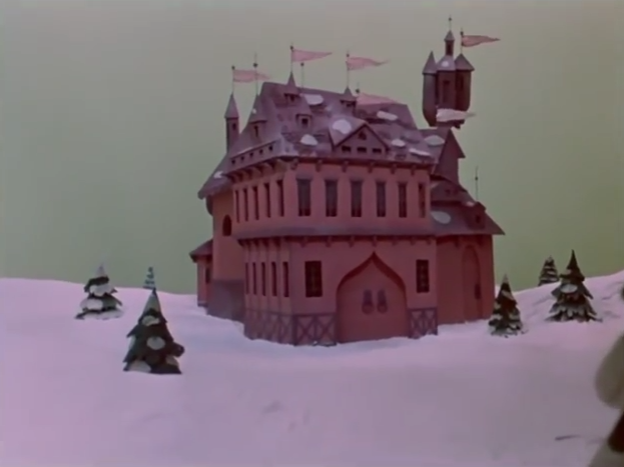
So this has been bothering me for years now: Santa can’t possibly live and run his massive toy operation from the North Pole. It’s physically impossible.
There is no land at the North Pole. If Santa does exist, he lives on a giant ice sheet floating about 13,000 feet above the floor of the Arctic Ocean. That thin bed of ice averages between 6 and 10 feet thick.
It’s been established that Santa lives in a house next to the toy making facilities operated by elves. It’s also been established that elves are smaller than humans. Presuming an elf is about one-third the size of a human, we can calculate precisely how many elves work and live at the North Pole, how much room they would need to perform their duties, and how much heat would be generated by such a massive operation.
First, we need to estimate the number and size of the toys produced each year. Knowing that toys range in size from the pocket-friendly Tamagotchi to fully-inflated Jumpy Castles, it would be beyond generous to suggest that the average toy be roughly the same size and weight of the Lego Star Wars Imperial Troop Transport battle pack, product #75078. This product measures 7.5 inches by 5.6 inches by 1.8 inches, and has a shipping weight of 4 ounces.
The United Nations estimates there are 7,223,297,000 billion people on the planet. Of that, about 1,841,870,000 are children ages 14 and under. We could add an additional 591,702,000 children ages 15-19, but I’m ruling them out because odds are they don’t believe in Santa, and therefore no longer qualify for free elvan presents.
That means that Santa’s elves have to produce 7,367,481,228 ounces of Legos each year – that’s over 460 million pounds of toys, or about 230,234 TONS of toys. Mind you, none of these are wrapped in paper yet, which is standard practice for Christmas presents, and presumes no bows or other wrapping decorations are added.

To calculate the size and weight of the wrapping paper needed, we simply need to apply the formula 2ab + 2bc + 2ac to the dimensions of Lego set #75078. That gives us a surface area of about 131.16 square inches. Knowing that the elves will need extra paper to help tape together the edges, a conservative estimate of 150 square inches will be used. That means Santa’s elves will have to produce, or at least stock, 276,280,546,050 square inches of paper, which is about 1,918,614,903 square feet of paper. If the elves bought standard 24″-wide spools of paper from Bob Kraft’s paper company, they’d need 19,186,149 spools. At 60 pounds each, that’s an additional 575,584 TONS of weight for just wrapping paper alone!!
This means Santa must own and maintain a massive storage warehouse to protect his toys and supplies from the brutal North Pole weather. To protect only the wrapped and ready-to-deliver toys, he’d need a warehouse that can fit 44,045 acres worth of toys, which is about 69 square miles!
Next, we need to know how many elves are needed to make, box, wrap, and store the toys. Presuming one elf handles each toy from gathering the raw materials at the supply warehouse through production, complete to delivery at the finished toy warehouse, we can generously estimate a time of one hour per toy. Note that this also presumes that each elf is rather speedy, as we’ve already established the warehouse space alone is measured in miles, not feet.
1,841,870,000 elf-hours worth of time would be necessary to make one toy for every boy and girl on the planet. I say this because no one knows any kid who didn’t qualify for a toy on Christmas. Though he threatens it every year, Santa has never been proven to have not given a kid a toy – hence, the Naughty/Nice list is a proven sham. That being said, presuming each elf sleeps only 4 hours a night, Santa would need 92,093,500 elf-days worth of toy production. Since it takes about 2 days for Santa to actually deliver the toys, AND presuming Santa flies his toy warehouse so that there is no transfer of toys necessary from warehouse to sleigh (the warehouse therefore also is a magical sleigh), the elves have 363.25 days produce the toys. That means Santa needs, at a minimum, 253,526 elves to manufacture toys.

Mind you, this doesn’t include inevitable industrial accidents, sick days, vacation days, personal time, or any other normal reasons an elf may not be able to work. With just 253,526 toy-manufacturing elves, we know there has to be at least a couple of pregnancies every year if only due to workplace shenanigans – shenanigans something being expected from magical creatures regularly described as frolicky and whimsical.
It would be reasonable to double that workforce for campus-related necessary jobs, such as bookkeeping, custodial services, shipping and receiving, general HR, security, and the like. After all, it is the North Pole, and occasionally a polar bear is going to walk by and consider snacking on the 2-foot-high elves – some elves will need to be patrolling the massive company grounds in self-defense.
All of this, by the way, presumes that no elves defect Santa’s camp and go work for another elvan organization. We know this happens, if only because of the massive Keebler cookie corporation.
That means that Santa would need, at minimum, at least another 84,509 elves to run the physical plant. Mind you, this does not include elves necessary to maintain the reindeer team, collect and files Santa’s massive delivery of letters from children, and other non-toymaking requirements, which we know is a critical part of his charity. A conservative estimate of 500,000 elves would be incredibly kind.
Lastly, and quite finally, we need to calculate the heat required to run Santa’s gigantic toy factory and corporate footprint. Presuming each elf needs only a laughable 15 square feet in which to stand and produce toys, Santa’s workshop would have to be 3,802,980 square feet, or .14 square miles of factory space. This is WELL OVER twice the size of the Pentagon in Washington, DC – and the Pentagon has a giant open park of unused space in its center!
If the factory were only 10 feet high (as elves are five times shorter than that), Santa’s factory would need to generate 67,377,844 BTU’s each hour to maintain a temperature of 70 degrees Fahrenheit. This presumes Santa paid for extremely efficient windows and insulation. It would take 19,746,506 watts of energy every hour to produce that heat.

As Santa seems to have a limitless supply of coal, it would be fair to presume that Santa powers his enterprise with coal power plants. A traditional steam electric generator powered by coal can produce about 19,210,000 BTUs for every 2000 pounds of coal. That means Santa needs about 7015 tons of coal every hour, or roughly 168,356 tons of coal every day for heating only his factory floor. This doesn’t include heat and electricity for the elf dormitories, warehouses, reindeer pens, the polar bear weapons armory, Santa’s infamous house, the massive mailroom, and the countless other buildings required.
Industrial coal burns at about 3500 degrees Fahrenheit. 2000 tons of coal takes up about 66,666 square feet of space. The burning space required to burn just one hour’s worth of coal would be 1.53 acres. That means that an extremely economic and fuel-efficient coal-powered space-age power generator would be a 1.5 acre block radiating 3500 degrees of heat, 24/7, 365 days a year!! And since Santa’s operation cannot shut down even for a moment, he’d need at least one duplicate back-up power station running at all times – doubling his need for coal, coal storage and delivery, and elves to work the plant, and creating another massive heating structure on the ice block upon which his enterprise is built!
The heat being thrown off by these plants would play roulette online in canada be matched by billowing clouds of toxic gasses helping dissolve an already-pierced ozone layer, which would translate into even faster melting of the foundational ice cap, as we know Santa’s castle spends six months of the year in constant sunlight.
Therefore, *IF* Santa ever lived at the North Pole with a massive group of elves and magical reindeer, *AND* he did continue to deliver toys to the boys and girls of Earth every Christmas, his operation would have become so huge that the heat generated by the gigantic undertaking would have been enough to melt all of the ice under and around the corporation in minutes. The sheer weight of the mountains of coal, never ending supplies of reindeer feed, and even the friction from all of those elvan feet and industrial vehicles would generate even more heat to the thick sheet of ice, and guarantee that the remaining warehouses and dormitories would quickly crack and shatter the entire property like a Mack truck driving through a bank window.

The point being – Santa and every one of his elves and reindeer would have drowned, and are now sitting 13,000 feet below the Arctic Ocean.
With Jack Dawson.
